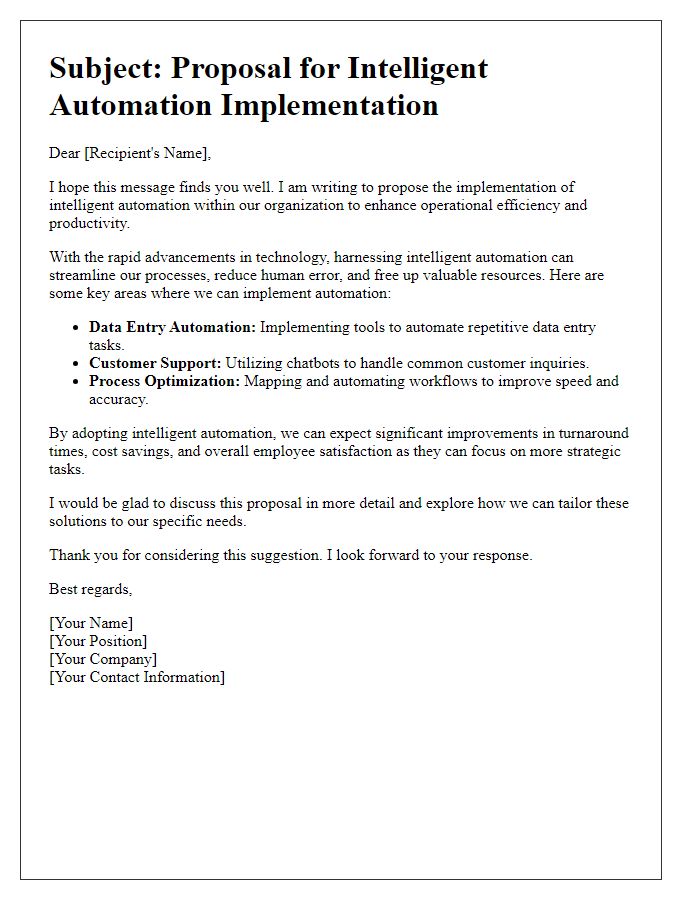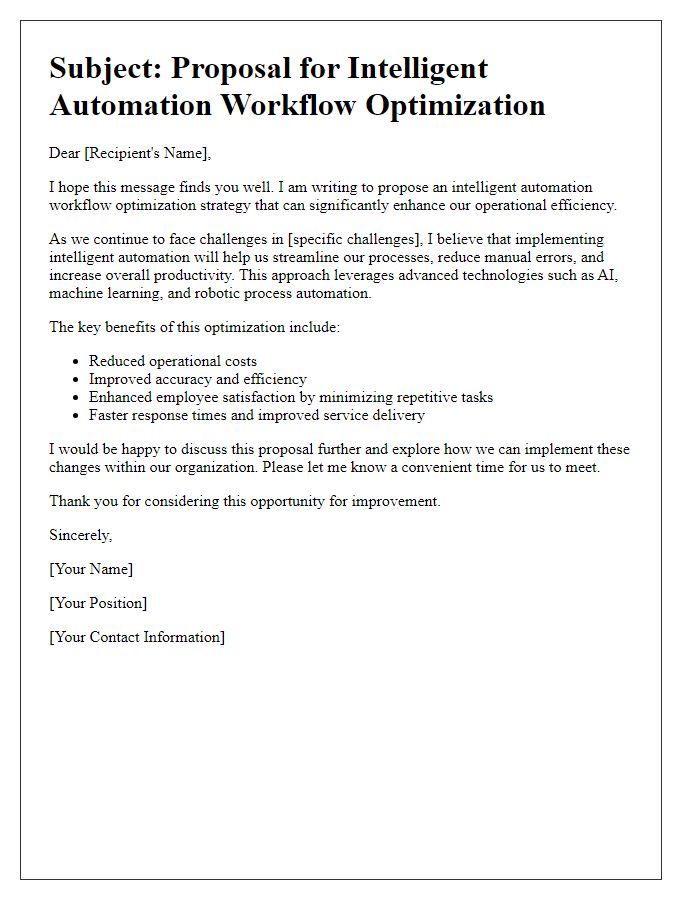Are you ready to revolutionize your business processes with intelligent automation? In today's fast-paced world, incorporating sophisticated automation solutions can drastically increase efficiency and reduce operational costs. Imagine a future where your team's workload is streamlined and more time is spent on innovation rather than routine tasks. Join us as we explore the transformative potential of intelligent automation in our latest article!

Overview of Intelligent Automation Benefits
Intelligent automation, a transformative technology integrating artificial intelligence (AI) and robotic process automation (RPA), offers significant advantages for businesses seeking efficiency and innovation. By streamlining repetitive tasks, intelligent automation reduces operational costs, with potential savings surpassing 30% in some industries, such as finance and manufacturing. Enhanced accuracy is achieved as software robots minimize human error, particularly in data entry processes that can lead to misplaced information or compliance violations. The deployment of AI-driven analytics enables businesses to derive actionable insights from vast datasets, improving decision-making and strategic planning over time. Enhancing employee satisfaction is another critical benefit, as staff can focus on higher-value activities instead of mundane tasks, promoting job enrichment. Additionally, intelligent automation accelerates process speed, with some organizations reporting up to 80% time savings in task completion, thereby fostering a quicker response to market changes and customer demands. Overall, intelligent automation stands as a pivotal innovation for organizations committed to optimizing operations and maintaining competitive advantage in an increasingly digital landscape.
Detailed Project Scope
Intelligent automation projects significantly enhance operational efficiency by integrating advanced technologies such as Artificial Intelligence (AI) and Robotic Process Automation (RPA). The project scope involves analyzing current workflows in industries including finance, healthcare, and manufacturing to identify repetitive tasks suitable for automation. Key performance indicators (KPIs) will be established to measure improvements post-implementation, focusing on time savings, error reduction, and cost efficiency. Furthermore, the project will include developing algorithms capable of processing large datasets, ensuring compliance with regulations such as GDPR in Europe and HIPAA in the U.S. The deployment phase will utilize cloud-based solutions, enabling scalability and flexibility while minimizing upfront expenses. Collaboration with stakeholders at sites like headquarters in New York City and operational branches in Chicago will be crucial for refining the automation strategy and addressing industry-specific challenges. Training sessions for employees will be scheduled at various intervals to facilitate smooth transitions to automated systems and ensure privacy and security adherence.
Cost-Benefit Analysis
Intelligent automation significantly transforms operational efficiency within various industries, such as manufacturing or finance, by integrating advanced technologies like robotic process automation (RPA) and artificial intelligence (AI). A comprehensive cost-benefit analysis is crucial for stakeholders, showcasing potential initial investments, which can range widely, with some implementations costing upwards of $100,000. Operational savings can exceed 30% annually in specific sectors, particularly when automating repetitive tasks. Moreover, increased accuracy leads to a reduction in error rates, which can save additional costs tied to correction processes. Enhancements in productivity often result in higher employee satisfaction, as teams can focus on creative problem-solving rather than mundane tasks, fostering innovation and job enrichment. Long-term benefits can extend to improved customer experience due to faster response times and reduced service delivery hours.
Implementation Timeline and Milestones
An intelligent automation project implementation timeline is essential for ensuring the successful integration of automated systems into existing workflows. The project typically begins with the planning phase, lasting approximately one month, focusing on identifying key processes for automation, gathering stakeholder requirements, and assessing current technological infrastructure, such as servers and software applications. Following this, the development phase spans four months where prototypes are created for automation solutions, including robotics process automation (RPA) tools, machine learning algorithms, and artificial intelligence (AI) integration. User acceptance testing will be conducted in the fifth month, allowing stakeholders to evaluate the functional capabilities of the system. Post-testing adjustments will follow, with a duration of two weeks. The deployment phase will take place in month six, during which the final solution is rolled out across the organization. Training sessions for employees on the new automated processes will accompany this rollout to ensure a smooth transition. Regular review milestones will be established every quarter, enabling assessment of performance metrics, solution effectiveness, and identification of areas for further improvement within the automation framework.
Risk Management and Mitigation Strategies
Intelligent automation (IA) has become essential in modern risk management processes, significantly streamlining operations and enhancing efficiency. By deploying robotics process automation (RPA) tools, organizations can reduce human error and increase compliance rates, especially in industries like finance and healthcare where data accuracy is critical. Risk assessment frameworks, such as ISO 31000, benefit from automation by facilitating real-time data analysis and reporting, allowing businesses to identify and mitigate risks rapidly. Specific use cases include automating routine risk reporting tasks, enabling teams to focus on strategic decision-making. Integrated AI systems can predict risk patterns based on historical data, providing actionable insights for proactive risk management. Implementing these advanced technologies not only minimizes operational risks but also fosters a culture of continuous improvement and resilience within organizations.













Comments